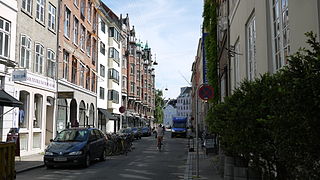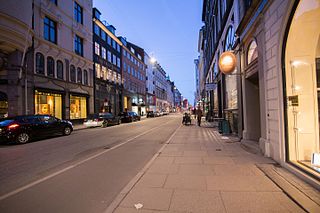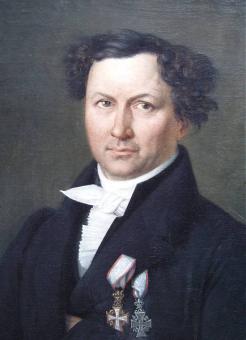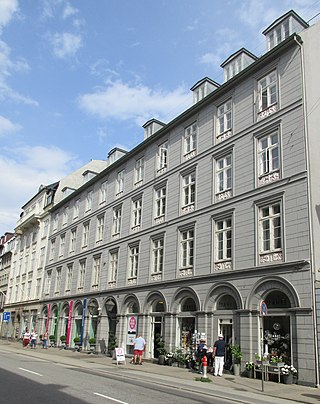Related Research Articles

The University of Copenhagen is a public research university in Copenhagen, Denmark. Founded in 1479, the University of Copenhagen is the second-oldest university in Scandinavia after Uppsala University.
The Faculty of Health and Medical Sciences at the University of Copenhagen houses 13 departments, 31 centres, five schools, four hospitals, and three libraries.

Rigshospitalet is the largest public and teaching hospital in Copenhagen and the most highly specialised hospital in Denmark. The hospital's main building is a 16-storey functionalist highrise, one of the tallest structures in the central parts of the city. Rigshospitalet neighbours the Panum Building which houses the Faculty of Health and Medical Sciences at the University of Copenhagen. As a teaching hospital it is part of the framework organisation Copenhagen University Hospital.

The royal Frederiks Hospital was Denmark's first hospital in the present-day meaning of the word. It was founded by king Frederik V and financed by the earnings from the Norwegian Postal Service.

Fødselsstiftelsen, also referred to as Fødsels- og Plejestiftelsen, was a Danish maternity institution in Amaliegade in Copenhagen, Denmark.

Søllerød is a suburban district of Rudersdal Municipality in the northern outskirts of Copenhagen, Denmark. The original village, one of the oldest in the area, is perched on Søllerød Hill on the south side of Søllerød Lake. It merged with the neighbouring village of Øverød to the north and the modern district of Holte to the southwest in the middle of the 20th century and now forms part of the Greater Copenhagen area.

Store Strandstræde is a street in Copenhagen, Denmark. It extends diagonally from Kongens Nytorv, at the corner of Nyhavn and Bredgade, to Sankt Annæ Plads. Lille Strandstræde joins the street shortly before reaching Sankt Annæ Plads.

Sankt Annæ Plads is a public square which marks the border between the Nyhavn area and Frederiksstaden neighborhoods of central Copenhagen, Denmark. It is a long narrow rectangle which extends inland from the waterfront, at a point just north of the Royal Danish Playhouse at the base of the Kvæsthus Pier, now known as Ofelia Plads, until it meets Bredgade. A major renovation of the square was completed in 2016.The Garrison Church is located on the south side of the square. Amaliegade, one of the two axes on which Frederiksstaden is centered, extends from the square.

Bredgade is one of the most prominent streets in Copenhagen, Denmark. Running in a straight line from Kongens Nytorv for just under one kilometre to the intersection of Esplanaden and Grønningen, it is one of the major streets in Frederiksstaden, a Rococo district laid out in the middle of the 18th century to commemorate the tercentenary of the House of Oldenburg's accession to the Danish throne. It is lined with a number of fine mansions as well as other historic buildings. Many law firms, trade unions, fashion stores and art galleries are based in the street. The street also runs parallel to the Royal residence Amalienborg and Frederik's Church

Jørgen Hansen Koch was a Neoclassical Danish architect. He was chief of the national Danish building administration from 1835 and director of the Royal Danish Academy of Fine Arts from 1844 to 1849.

Esplanaden is a street in Copenhagen, Denmark. It extends eastwards from Store Kongensgade and runs along the south side of the city's 17th-century fortress Kastellet and Churchillparken until it reaches the waterfront at Nordre Toldbod, just south of Langelinie, passing Amaliegade, Bredgade and Grønningen on the way. It marks the northern border of the Frederiksstaden district.
Events from the year 1787 in Denmark.

Medical Museion is a museum and research unit in Copenhagen, Denmark, dedicated to the history of health and disease in a cultural perspective. Part of the Faculty of Health and Medical Sciences at University of Copenhagen, its principal area of interest is the recent history of the material and iconographic culture of biomedicine. It is based in a listed building from 1787 on Bredgade in Frederiksstaden.

Borgergade is a street in central Copenhagen, Denmark. It runs from Gothersgade to Store Kongensgade. As one of relatively few streets in central Copenhagen, the street, in its western part, is dominated by modern buildings. The eastern part passes through the Nyboder district.

The Moltke's Mansion is a town mansion on the corner of Bredgade and Dronningens Tværgade in Copenhagen, Denmark. It is one of several town mansions in Frederiksstaden, although it actually predates the neighbourhood by half a century. It was built for Ulrik Frederik Gyldenløve between 1700 and 1702 and was originally known as Gyldenløve's Little Mansion. It received its current name in 1842, after it was acquired by Adam Wilhelm Moltke, the first Danish Prime Minister under the Danish constitutional monarchy.
Theatrum Anatomico-chirurgicum was an anatomical theatre which existed from 1736 until 1785 in Copenhagen, Denmark. It was built as a replacement for Domus Anatomica which had been destroyed in the Copenhagen Fire of 1728 and was itself succeeded by the Royal Danish Academy of Surgery.

The Copenhagen Amber Museum is a museum on Kongens Nytorv in central Copenhagen, Denmark. The museum is owned by House of Amber. The museum holds an extensive collection of amber antiques and artifacts, including a wide array of entombed insects from prehistoric times. The collection comprises one of the largest piece of amber in the world.

Adelgade is a street in central Copenhagen, Denmark. It runs from Gothersgade in the south to Sankt Pauls Plads with St. Paul's Church in the north. The first half of the street is dominated by modern buildings while its last section passes through the Nyboder district.
The North Campus is one of the University of Copenhagen's four campuses in Copenhagen, Denmark. It is situated just north of the city centre, across from Copenhagen's largest park, Fælledparken, and between the Østerbro and Nørrebro districts. It is home to the Faculty of Science and the Faculty of Health and Medical Sciences.

The Grandjean House is a Late Neoclassical property consisting of two separate buildings, one at Bredgade 4 and one at Store Strandstræde 3, on opposite sides of a central courtyard, in central Copenhagen, Denmark. The property is separated from Kongens Nytorv by a small building that now houses Copenhagen Amber Museum. It was built in 1854 by the architect Christian Tybjerg for pastry chef Christian Bredo Grandjean. It replaced an older building, which was known as the Collin House after Hans Christian Andersen patron Jonas Collin, but this name is now associated with another building in Amaliegade. The Grandjean House was listed on the Danish registry of protected buildings and places in 1959.
References
- ↑ "1785" (in Danish). Selskabet for Københavns Historie. Retrieved 2012-04-19.
- ↑ "Kirurgisk Akademi" (in Danish). Gyldendal. Retrieved 2012-04-19.